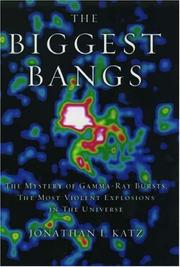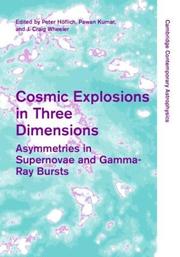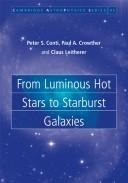| Listing 1 - 9 of 9 |
Sort by
|
Book
ISBN: 9780521662093 9780511980336 9781139568715 113956871X 1283812347 9781283812344 0511980337 0521662095 9781139570527 1139570528 9781139573177 1139573179 1139579134 1139886789 1139572288 1139569627 Year: 2012 Publisher: Cambridge : Cambridge University Press,
Abstract | Keywords | Export | Availability | Bookmark
 Loading...
Loading...Choose an application
- Reference Manager
- EndNote
- RefWorks (Direct export to RefWorks)
"Cosmic gamma ray bursts (GRBs) have fascinated scientists and the public alike since their discovery in the late 1960s. Their story is told here by some of the scientists who participated in their discovery and, after many decades of false starts, solved the problem of their origin. Fourteen chapters by active researchers in the field present a detailed history of the discovery, a comprehensive theoretical description of GRB central engine and emission models, a discussion of GRB host galaxies and a guide to how GRBs can be used as cosmological tools. Observations are grouped into three sets from the satellites CGRO, BeppoSAX and Swift, and followed by a discussion of multi-wavelength observations. This is the first edited volume on GRB astrophysics that presents a fully comprehensive review of the subject. Utilizing the latest research, Gamma-ray Bursts is an essential desktop companion for graduate students and researchers in astrophysics"--
Gamma ray bursts --- Gamma ray bursts. --- Bursts, Cosmic gamma ray --- Bursts, Gamma ray --- Cosmic gamma ray bursts --- Transients, Gamma ray --- Gamma ray astronomy --- X-ray bursts

ISBN: 1280531924 9786610531929 1423722485 0198033338 1602568758 0195145704 9780195145700 9781423722489 9781280531927 9781602568754 0197732089 Year: 2002 Publisher: Oxford New York Oxford University Press
Abstract | Keywords | Export | Availability | Bookmark
 Loading...
Loading...Choose an application
- Reference Manager
- EndNote
- RefWorks (Direct export to RefWorks)
For over 25 years, gamma-ray bursts were the outstanding mystery in astronomy. No one knew where they were or how they worked. This book tells how the mystery was unravelled, from the discovery of bursts by a satellite system to their observation.
Gamma ray bursts. --- Bursts, Cosmic gamma ray --- Bursts, Gamma ray --- Cosmic gamma ray bursts --- Transients, Gamma ray --- Gamma ray astronomy --- X-ray bursts

ISBN: 0521842867 Year: 2004 Publisher: Cambridge, UK ; New York : Cambridge University Press,
Abstract | Keywords | Export | Availability | Bookmark
 Loading...
Loading...Choose an application
- Reference Manager
- EndNote
- RefWorks (Direct export to RefWorks)
Supernovae. --- Gamma ray bursts. --- Supernovae --- Gamma ray bursts --- Supernovas --- Cataclysmic variable stars --- X-ray sources, Galactic --- Bursts, Cosmic gamma ray --- Bursts, Gamma ray --- Cosmic gamma ray bursts --- Transients, Gamma ray --- Gamma ray astronomy --- X-ray bursts

ISBN: 9780511536236 9780521842860 9781107403116 9780511265693 0511265697 0511261780 9780511261787 0511263406 9780511263408 0511264216 9780511264214 0511536232 1280749733 9781280749735 0521842867 1107163560 9786610749737 0511264976 0511317409 Year: 2004 Publisher: Cambridge, UK ; New York : Cambridge University Press,
Abstract | Keywords | Export | Availability | Bookmark
 Loading...
Loading...Choose an application
- Reference Manager
- EndNote
- RefWorks (Direct export to RefWorks)
Supernovae and gamma-ray bursts are the strongest explosions in the Universe. Observations show that, rather than being symmetrical, they are driven by strong jets of energy and other asymmetrical effects. These observations demand theories and computations that challenge the biggest computers. Originally published in 2004, this volume marked the transition to a fresh paradigm in the study of stellar explosions. It highlights the burgeoning era of routine supernova polarimetry and the insights into core collapse and thermonuclear explosions. With chapters by leading scientists, the book summarises the status of a fresh perspective on stellar explosions and should be a valuable resource for graduate students and research scientists.
Supernovae. --- Gamma ray bursts. --- Bursts, Cosmic gamma ray --- Bursts, Gamma ray --- Cosmic gamma ray bursts --- Transients, Gamma ray --- Gamma ray astronomy --- X-ray bursts --- Supernovas --- Cataclysmic variable stars --- X-ray sources, Galactic

ISBN: 9780521791342 0521791340 9780511536199 9781107407732 9780511457494 0511457499 0511456182 9780511456183 9780511454455 0511454457 9780511455483 0511455488 1107194814 1281944815 9786611944810 0511453477 0511536194 Year: 2008 Publisher: Cambridge, UK ; New York : Cambridge University Press,
Abstract | Keywords | Export | Availability | Bookmark
 Loading...
Loading...Choose an application
- Reference Manager
- EndNote
- RefWorks (Direct export to RefWorks)
Luminous hot stars represent the extreme upper mass end of normal stellar evolution. Before exploding as supernovae, they live out their lives of a few million years with prodigious outputs of radiation and stellar winds, dramatically affecting both their evolution and environments. A detailed introduction to the topic, this book connects the astrophysics of massive stars with the extremes of galaxy evolution represented by starburst phenomena. A thorough discussion of the physical and wind parameters of massive stars is presented. HII galaxies, their connection to starburst galaxies, and the contribution of starburst phenomena to galaxy evolution through superwinds, are explored. The book concludes with the wider cosmological implications, including Population III stars, Lyman break galaxies and gamma-ray bursts, for each of which massive stars are believed to play a crucial role. This book is ideal for graduate students and researchers in astrophysics interested in luminous hot stars and galaxy evolution.
Starbursts --- Gamma ray bursts --- Stars --- Stellar winds --- Etoiles --- Vents stellaires --- Evolution --- Starbursts. --- Gamma ray bursts. --- Stellar winds. --- Winds, Stellar --- Space plasmas --- Stellar activity --- Stellar evolution --- Compact objects (Astronomy) --- Bursts, Cosmic gamma ray --- Bursts, Gamma ray --- Cosmic gamma ray bursts --- Transients, Gamma ray --- Gamma ray astronomy --- X-ray bursts --- Star bursts --- Starburst galaxies --- Evolution. --- Winds
Book
ISBN: 3319066269 3319066250 Year: 2014 Publisher: Cham : Springer International Publishing : Imprint: Springer,
Abstract | Keywords | Export | Availability | Bookmark
 Loading...
Loading...Choose an application
- Reference Manager
- EndNote
- RefWorks (Direct export to RefWorks)
Nominated as an outstanding thesis by the Department of Physics and Astronomy of the University of New Mexico, this thesis seeks to identify the gamma-ray burst (GRB) progenitor. GRBs are extragalactic explosions that briefly outshine entire galaxies, but the mechanism that can release that much energy over a < 100 second burst is still a mystery. The leading candidate for the GRB progenitor is currently a massive star which collapses to form a black hole–accretion disk system that powers the GRB. GRB afterglows, however, do not always show the expected behavior of a relativistic blast wave interacting with the stellar wind that such a progenitor should have produced before its collapse. In this book, the author uses the Zeus-MP astrophysical hydrodynamics code to model the environment around a stellar progenitor prior to the burst. He then develops a new semi-analytic MHD and emission model to produce light curves for GRBs encountering these realistic density profiles. The work ultimately shows that the circumburst medium surrounding a GRB at the time of the explosion is much more complex than a pure wind, and that observed afterglows are entirely consistent with a large subset of proposed stellar progenitors.
Gamma ray bursts. --- Gamma ray sources. --- Bursts, Cosmic gamma ray --- Bursts, Gamma ray --- Cosmic gamma ray bursts --- Transients, Gamma ray --- Gamma ray astronomy --- X-ray bursts --- Gamma ray production --- Gamma sources --- Sources, Gamma ray --- Gamma rays --- Radiation sources --- Astrophysics. --- Mathematical physics. --- Space Sciences (including Extraterrestrial Physics, Space Exploration and Astronautics). --- Mathematical Methods in Physics. --- Physical mathematics --- Physics --- Astronomical physics --- Astronomy --- Cosmic physics --- Mathematics --- Space sciences. --- Physics. --- Natural philosophy --- Philosophy, Natural --- Physical sciences --- Dynamics --- Science and space --- Space research --- Cosmology --- Science
Book
ISBN: 3540390855 354039088X Year: 2009 Publisher: Berlin ; New York : Chichester, UK : Springer ; In association with Praxis Pub.,
Abstract | Keywords | Export | Availability | Bookmark
 Loading...
Loading...Choose an application
- Reference Manager
- EndNote
- RefWorks (Direct export to RefWorks)
Since their discovery was first announced in 1973, gamma-ray bursts (GRBs) have been among the most fascination objects in the universe. While the initial mystery has gone, the fascination continues, sustained by the close connection linking GRBs with some of the most fundamental topics in modern astrophysics and cosmology. Both authors have been active in GRB observations for over two decades and have produced an outstanding account on both the history and the perspectives of GRB research.
Gamma ray bursts. --- Gamma-Burst. --- Gamma ray bursts --- Astronomy - General --- Astrophysics --- Astronomy & Astrophysics --- Physical Sciences & Mathematics --- X-ray bursts. --- Bursts, Cosmic gamma ray --- Bursts, Gamma ray --- Cosmic gamma ray bursts --- Transients, Gamma ray --- Burst sources, X-ray --- Bursts, X-ray --- Sources of X-ray bursts --- X-ray burst sources --- X-ray bursters --- Physics. --- Astronomy. --- Astrophysics. --- Cosmology. --- Astronomy, Astrophysics and Cosmology. --- Astronomy --- Deism --- Metaphysics --- Astronomical physics --- Cosmic physics --- Physics --- Physical sciences --- Space sciences --- Natural philosophy --- Philosophy, Natural --- Dynamics --- X-ray astronomy --- Gamma ray astronomy --- X-ray bursts
Book
ISBN: 0387095470 9786612290787 1282290789 0387095489 3540095470 3540348654 3540095489 3540348638 9783540095477 9783540095484 9780387095486 Year: 1979 Volume: 745 Publisher: Berlin: Springer,
Abstract | Keywords | Export | Availability | Bookmark
 Loading...
Loading...Choose an application
- Reference Manager
- EndNote
- RefWorks (Direct export to RefWorks)
The exceptional cosmic history and the fabulous destinies of exploding stars - supernovae and gamma-ray bursters - are highly fertile areas of research and are also very special tools to further our understanding of the universe. In this book, cosmologists Dr Alain Mazure and Dr Stéphane Basa throw light on the assemblage of facts, hypotheses and cosmological conclusions and show how these beacons' illuminate their immediate surroundings and allow us to study the vast cosmos, like searchlights revealing the matter comprising our universe.
Cosmology. --- Gamma ray bursts. --- Supernovae. --- Subnormal operators --- Mathematics --- Astronomy & Astrophysics --- Physical Sciences & Mathematics --- Calculus --- Astrophysics --- Mathematical Theory --- Supernovas --- Bursts, Cosmic gamma ray --- Bursts, Gamma ray --- Cosmic gamma ray bursts --- Transients, Gamma ray --- 517.13 --- Theory of real numbers --- Subnormal operators. --- 517.13 Theory of real numbers --- Topological rings --- Rings, Topological --- Topological rings. --- Physics. --- Gravitation. --- Astronomy. --- Astrophysics. --- Observations, Astronomical. --- Astronomy --- Space sciences. --- Astronomy, Observations and Techniques. --- Astrophysics and Astroparticles. --- Extraterrestrial Physics, Space Sciences. --- Popular Science in Astronomy. --- Astronomy, Astrophysics and Cosmology. --- Classical and Quantum Gravitation, Relativity Theory. --- Observations. --- Operator theory --- Ordered algebraic structures --- Cataclysmic variable stars --- X-ray sources, Galactic --- Gamma ray astronomy --- X-ray bursts --- Commutative rings --- Associative rings --- Associative rings. --- Commutative rings. --- Rings (Algebra) --- Algèbres associatives --- Algèbres commutatives --- Algèbres topologiques --- Groupes topologiques --- Analyse fonctionnelle --- Operateurs lineaires hilbertiens --- Espaces de hilbert --- Operateurs lineaires
Book
ISBN: 1400837006 9786613001283 1283001284 9781400837007 9780691145563 0691145563 9780691145570 0691145571 6613001287 9781283001281 Year: 2011 Publisher: Princeton : Princeton University Press,
Abstract | Keywords | Export | Availability | Bookmark
 Loading...
Loading...Choose an application
- Reference Manager
- EndNote
- RefWorks (Direct export to RefWorks)
Gamma-ray bursts are the brightest--and, until recently, among the least understood--cosmic events in the universe. Discovered by chance during the cold war, these evanescent high-energy explosions confounded astronomers for decades. But a rapid series of startling breakthroughs beginning in 1997 revealed that the majority of gamma-ray bursts are caused by the explosions of young and massive stars in the vast star-forming cauldrons of distant galaxies. New findings also point to very different origins for some events, serving to complicate but enrich our understanding of the exotic and violent universe. What Are Gamma-Ray Bursts? is a succinct introduction to this fast-growing subject, written by an astrophysicist who is at the forefront of today's research into these incredible cosmic phenomena. Joshua Bloom gives readers a concise and accessible overview of gamma-ray bursts and the theoretical framework that physicists have developed to make sense of complex observations across the electromagnetic spectrum. He traces the history of remarkable discoveries that led to our current understanding of gamma-ray bursts, and reveals the decisive role these phenomena could play in the grand pursuits of twenty-first century astrophysics, from studying gravity waves and unveiling the growth of stars and galaxies after the big bang to surmising the ultimate fate of the universe itself. What Are Gamma-Ray Bursts? is an essential primer to this exciting frontier of scientific inquiry, and a must-read for anyone seeking to keep pace with cutting-edge developments in physics today.
Gamma ray bursts. --- Stars --- Birth, Stellar --- Formation, Star --- Formation, Stellar --- Stellar birth --- Stellar formation --- Bursts, Cosmic gamma ray --- Bursts, Gamma ray --- Cosmic gamma ray bursts --- Transients, Gamma ray --- Gamma ray astronomy --- X-ray bursts --- Formation. --- Evolution --- GRB afterglows. --- GRB. --- GRBs. --- NASA GRB satellite. --- Partial Test Ban Treaty. --- Ray Klebesadel. --- Swift satellite. --- Vela Satellite Program. --- X-ray emission. --- afterglow emission. --- afterglow theory. --- afterglow. --- afterglows. --- anomalous X-ray pulsars. --- astronomers. --- astrophysics. --- big bang. --- central engine behavior. --- cosmic phenomena. --- cosmic rays. --- dust. --- electromagnetic spectrum. --- explosion propertie. --- galaxies. --- gamma-ray bursts. --- gas. --- gravitational waves. --- gravity waves. --- high-energy emission. --- neutrinos. --- neutron stars. --- nuclear testing. --- panchromatic observations. --- progenitors. --- reionization. --- relativistic shocks. --- scientific inquiry. --- soft Gamma-ray Repeaters. --- star formation. --- supernova. --- young stars.
| Listing 1 - 9 of 9 |
Sort by
|

 Search
Search Feedback
Feedback About UniCat
About UniCat  Help
Help News
News